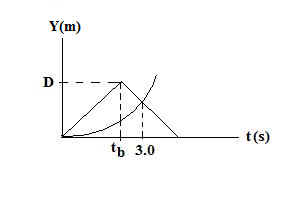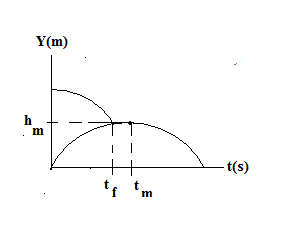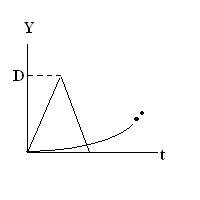QUIZ 3
|
||||
|
Turn in the
following exercises/problems next week:
Ch. 2 Free Fall exercise/problems 35, 40, 41, 44, 48, 47, 80, 81, 84
,88, 87, 89. (*DISCUSSIONS PROVIDED SO
FAR; some problems may not have discussions but still are due.) |
||||
| MORE DISCUSSIONS TO FOLLOW: CHECK BACK FREQUENTLY | ||||
| 44. Study Problem 89, especially part (a), discussion below in detail. Notice differences and similarities. In particular compare the sandbag's motion with the helicopter's after shut off or Austin Powers' trajectory after he "steps off" copter such that his initial velocity in free fall, before turning on jets, is up relative to ground. Same equations/formulae. In both problems, Austin Powers and sandbag move upward initially relative to ground despite "stepping off" with zero velocity with respect to rising vessel. | ||||
| 80. SOLVE A VERTICAL FREE FALL EQUATION FOR TIME OF FLIGHT OF EGG. THEN SUBSTITUTE INTO PROFESSOR'S UNIFORM HORIZONTAL MOTION EQUATION. | ||||
| 12th edition and 13th edition correspondence: 39..35, 40...40, 41...41, 44...44*, 48....48, 49....47, 76.....80*, 77....,81, 80........84*, 84.....88*, 85....87*, 86...89*. | ||||
| 84. SET UP THE SYSTEM OF EQUATIONS FOR THE PROBLEM.
TIP: LET DOWN BE POSITIVE. Thus a = +g. Set the top level
(windowsill) to be Y1 = 0 , the top of the window
at Y2 and the bottom of the window at Y3. Note: Since the pot was
dropped, V1 = 0. You are given 1.90 m = (V3 + V2)*(0.420 s) /2
and you also know V3 = V2 + g*(0.420 s) . Solve these two equations simultaneously for V3 and V2. Then use Y2 - Y1 = V22/(2g). Note: t3 - t2 = 0.420 seconds. YOU CAN ALSO FIND THE SOLUTION USING ANOTHER SET OF EQUATIONS RELYING MORE ON TIME. I.E., Y3 - Y2 = 1.90 m = V2*(t3 - t2)+ (1/2)*g*(t3 - t2)2 from which you can get V2, requested quantity. THE PROBLEM COULD BE RELEVANT IN A CRIME OR INSURANCE INVESTIGATION: For example investigators are trying to find V2 to determine the speed of t pot at impact with someone injured while walking on ground below. |
||||
88**. Let down be the positive direction of motion. The triangular shape represents the sound's motion, tb the time it takes sound to get to bottom, 3.0 seconds the time it takes sound and professor to meet while she moves downward in positive direction, and D the cliff's height. The parabola represents her free fall motion. The slope of inclined triangular sections are + 340 m/s and - 340 m/s moving right in time, respectively. Solve for D = 340*tb. Use information to find tb, geometrically if necessary. 3.0 seconds is the time when the two objects have the same X; use properties of lines, parabolas vertexed at origin. FURTHER COMMENTS: Think of a horizontal one dimensional race of sorts between a sound pulse and someone speeding up to the right with acceleration 9.8 m/s^2. As soon as I start I send a sound signal in the forward direction toward a vertical wall at the far right.. That signal will bounce off the wall and pass through me as it moves in the opposite direction and I move in the initial direction toward the wall. An echo. The shape of the sound signal's position vs time will be a triangle. Like a pyramid. As you move to the right in time, the pyramid slopes upward at an incline whose tangent equals the speed of sound. At peak of pyramid, the sound hits the wall, and as the pulse returns in the opposite direction, the curve traced out is a straight line with decreasing values of D as you move away from peak in time—the slope of this segment is the negative of the speed of sound. Find the intersection of pyramid segment and parabola representing your position vs time given by (1/2(*g*t^2. This requires some care since mathematically it could be on either side of the peak in time. To the left of the peak in time means we catch up with the sound, highly unlikely and mathematically impossible since the speed of sound is over 300 m/s and we start from rest. In theory I could catch up with the sound if someone launched me with huge initial velocity from a strong enough spring loaded cannon (LOL). So the intersection is to the right of the peak in time. Use the equation of a line with negative slope -340 m/s. The intersection between the parabola and that line segment happens at 3 seconds. The value of the pyramid will be D – 340*(t – tb), where tb is the time it takes the sound to hit the bottom, t = 3 seconds and D is the depth of the cliff whose bottom the sound hits. You have : D – 340*(t – tb) = (1/2)*gt2, where t = 3 seconds. . We need to find D and we will know everything we need to know about the situation. But D = 340*tb . Thus, 340*tb – 340*(t – tb) = (1/2)*gt2 from whence you get tb and finally D. NOTE: THE DIAGRAM ABOVE IS NOT TO SCALE AND SHOULD BE
RE-DRAWN TO BETTER REFLECT
THE SITUATION. IN PARTICULAR,
THE PICTURE
LOOKS
MORE LIKE THIS: NOTE THE POOR PROFESSOR, WHO REPRESENTS THE PARABOLA ABOVE, REACHES DEPTH D IN A TIME OVER THREE TIMES 3.0 SECONDS, THE INSTANT HE/SHE HEARS THE ECHO. THE TWO DOTS REPRESENTS A CONTINUATION OF THE PARABOLA TO
THE POINT WHERE PROFESSOR HITS GROUND, the parabola reaching
value D. (HOPE A TRAMPOLINE ALLOWED HIM/HER TO
SURVIVE---MAYBE HE/SHE LANDED ON REALLY SOFT
PILLOWS!). |
||||
| 87. Let up be the positive direction. (a) and (b) are
basic as is (d) once you get (c): (c)  At time t = 0, the first ball is dropping from rest downward from height 3.0 m and second ball is thrown upward with speed equal to two-thirds the value computed in part (a). Two parabolas are shown , vertexed at point (0, 3.0), where 3.0 is in meters (m) and at (tm, hm), where tm and hm are the time and value of maximum height reached by second ball. Solve for tf, the time when they pass. (d) y = (2/3)*v1 - (1/2)*g*t2. , where t is time from part (c) and is velocity from part (a) |
||||
| 89. SYNOPSIS OF HINT TO #89 PART (b). NOTE: t^2 means t2. FOR
PART (a), see the methods of #44 above.
|
